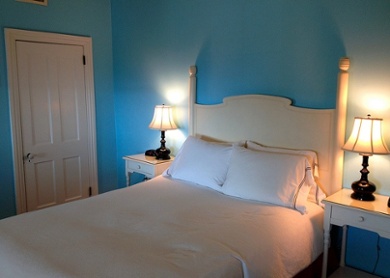Everyone knows that the colors we’re surrounded by can affect our moods. Rooms with lots of soft yellow are often perceived as warm and welcoming, for example, while gray rooms are often cool and neutral. From the pastels in your kitchen to the shades in your workplace, colors affect how we interpret the ambiance of a room and can constantly affect us while we’re awake.
But can the color of a room affect our mood while we’re asleep too?
Can the color of a bedroom influence our sleep patterns?
An investigation conducted by Travelodge attempted to answer this question by surveying over 2000 homes to ascertain how bedroom color played into sleep time. And they found some interesting results.
Want to sleep well? Paint your room blue
People who had blue bedrooms got the most sleep out of any color category (nearly 8 hours per night). The color blue is associated with calm and relaxation, and has even been shown to reduce blood pressure and to relax the mind. That makes for a good segway into a night of sleep!
Yellow and green were also shown to be relatively sleep-inducing colors.
…But avoid that purple decor!
People who slept in purple rooms had the worst sleep quality, averaging just shy of six hours per night. Apparently, this is because purple is a mentally stimulating color that can be hard to tune out when it’s time ot close your eyes and fall asleep.
How does color influence sleep patterns?
It is clear that there is a connection between our eyes and our sleep patterns. After all, our eyes’ perception of lightness and darkness governs our circadian rhythms and signals our body when to wake and sleep. So it makes sense that color can influence our proclivity to sleep.
So if you want to get the best night’s sleep you can, think about adding more than a few splashes of cerulean to your bedroom. And if you want to be productive during the work day, make sure your cubicle doesn’t remind you of the ocean.
Are you concerned that you or a loved one may suffer from excessive daytime sleepiness? Take this quiz and share the results with your doctor.
Other posts you may find interesting:
- When Should You Drink Your Morning Coffee?
- Bedtime Yoga to Help You Sleep
- How Does Sleep Affect Exercise Recovery?
- Watching TV in Bed: The Common Habit That Spoils Your Sleep
- Does Pre-bed Video Gaming Ruin Your Sleep?
Photo Credit: Cape May, NJ by Kathryn Yengel, CC license



Comments
riru
Posted on March 25, 2017what about lavender? it’s a shade of purple, but it’s a relaxing color.
Julia Rodriguez
Posted on March 27, 2017Hi Riru. Good question. I suppose it depends on the shade of lavender- which can range from just a lighter version of purple to a more grayish or bluish tint. The article referenced in this post (http://www.dailymail.co.uk/news/article-2325476/Want-good-nights-sleep-Find-colours-use-bedroom-avoid-decent-kip.html) suggests that purple is harmful to sleep because it is a stimulating color. If lavender has a calming or relaxing effect for you then it shouldn’t be a problem. -Julia